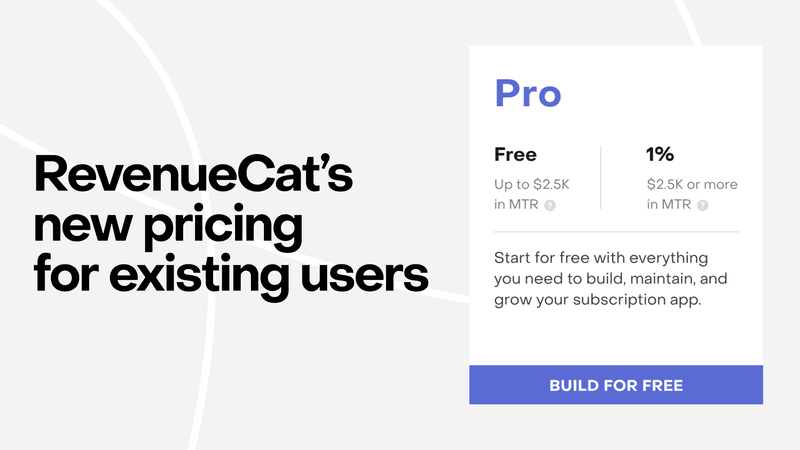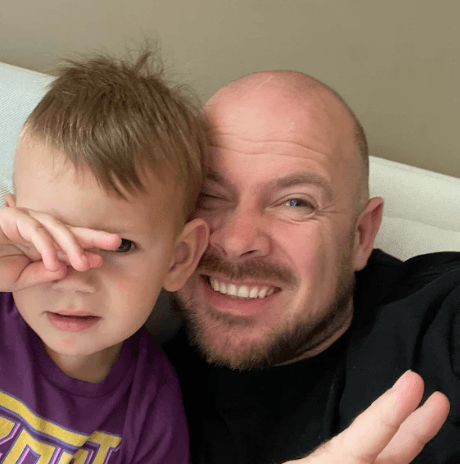Navigating RevenueCat’s new pricing for existing users
A detailed guide to understanding the changes, benefits, and potential downsides of migrating to our updated pricing


Rik Haandrikman
We recently launched new pricing. Jacob explained why, but the TLDR is that we built a lot of features that help developers make (even) more money, and we want to make sure each and every one of our users has access to those features.
Even though the reception has been positive, for some existing users we didn’t properly answer the pivotal question: “What does this mean for me?”. In this post, we’ll delve into the specifics of each legacy plan, comparing them with our new pricing, and highlighting the potential benefits and considerations of making the switch. Whether you’re on our legacy Free, Pro, Starter, or even one of our older plans, we’ve got you covered.
Note that we won’t force you to migrate to our new pricing: We fully believe that this change is a win for everyone that does migrate, but if you want to stay put on your current plan, that’s totally fine.
Legacy Free plan
Current conditions
You have access to all platform SDKs, our Stripe integration, Paywalls, the RevenueCat subscription backend, overview metrics, customer profiles, and customer lists.
Your plan is free, up to the moment you hit $10,000 in monthly tracked revenue (MTR). At that point, you’ll need to switch to a paid plan.
What would change in new pricing?
You’ll gain access to custom customer lists, webhooks, Charts, Experiments, scheduled data exports, and integrations like:
- Slack
- Apple Search Ads, and Facebook Ads
- Adjust, Appsflyer, Branch, Braze, Clevertap, Firebase, Intercom, OneSignal, and (many) more
You’ll continue paying $0, unless you generate more than $2,500 in MTR in any given month. In those months, you’ll be charged 1% of your MTR.
Benefits of migrating
We built the features in this new plan to help you grow faster, and – based on the billions of subscription revenue we see yearly – they’re likely to deliver:
Via RevenueCat charts, you’ll have a clear, single source of truth on your app’s performance. You’re able to break many charts down into segments, cohorts, and other useful views that will help you pinpoint issues and opportunities.
Many of our integrations are built to help you engage customers, drive conversions, or reactivate them when they churn. On the new plan, integrating those can help you drive tangible revenue growth. Many of the partners we integrate with have free plans as well, making it easy to test some of the most common use cases.
We also have several integrations with attribution tooling or advertising platforms, which will help you tap into new pockets of growth, which translates into more users and more revenue for your app.
Lastly, our Experiments feature allows you to kick off pricing and packaging experiments without touching any code, while producing deep insights into their performance via our charts and metrics. The result is more experiments that lead to more confident results, which lead to iterative improvements in everything from conversion to revenue per user.
TLDR: You’re getting access to all these – and more – features that’ll make it more likely you’ll grow. You’re more likely to grow faster, and if you don’t grow, you won’t pay us for any of the above anyway.
Considerations
If you’re growing, you’ll start paying us sooner: When you hit $2,500 rather than at $10,000 in monthly tracked revenue.
Legacy Starter plan
Current conditions
You have access to all platform SDKs, our Stripe integration, Paywalls, the RevenueCat subscription backend, overview metrics, customer profiles, and customer lists.
You also have access to Charts, webhooks, custom customer lists, and our Slack and Firebase integrations.
Your plan is free, up to the moment you hit $1,000 in monthly tracked revenue (MTR). At that point, you’re charged 0.8% of MTR.
Differences with new pricing
You’ll gain access to Experiments, scheduled data exports, and integrations like:
- Slack
- Apple Search Ads, and Facebook Ads
- Adjust, Appsflyer, Branch, Braze, Clevertap, Intercom, OneSignal, and (many) more
You’ll continue paying $0, unless you generate more than $2,500 in MTR in any given month. In those months, you’ll be charged 1% of your MTR.
Benefits of migrating
You’ll gain access to the RevenueCat features that weren’t included in your Starter plan, and that most strongly correlate to more – and faster – growth:
Numerous unlocked integrations are built to help you engage customers, drive conversions, or reactivate them when they churn. On the new plan, using those can help you drive tangible revenue growth. Many of the partners we integrate with have free plans as well, making it easy to test some of the most common use cases.
Several integrations with attribution tooling or advertising platforms, which will help you tap into new pockets of growth, which translates into more users and more revenue for your app.
Our Experiments feature allows you to kick off pricing and packaging experiments without touching any code, while producing deep insights into their performance via our charts and metrics. The result is more experiments that lead to more confident results, which lead to iterative improvements in everything from conversion to revenue per user.
TLDR: You’re getting access to these – and more – features that’ll make it more likely you’ll grow and grow faster.
Considerations
If you’re above $2,500 in MTR, you’ll be charged %1 of tracked revenue instead of the 0.8% you’re being charged on Starter today. That’s a significant increase.
If you’re below $2,500 in MTR your RevenueCat invoice would be $0 right now, but if and when you start paying, you’ll be charged a higher rate compared to your Starter plan.
Note that, if the Pro features help you drive even .25% more revenue than you’re generating today, the migration paid for itself. And we’ve seen countless examples of experiments leading to double digit improvements.
Legacy Pro plan
Current conditions
You have access to our full feature set.
Your plan is free, up to the moment you hit $1,000 in monthly tracked revenue (MTR). At that point, you’re charged 1.2% of MTR.
Differences with new pricing
Instead of paying us when you hit $1,000, you’ll only be charged in months where you generate more than $2,500 in monthly tracked revenue.
If and when you pay us, you’re charged 1% of MTR.
Benefits of migrating
You’ll pay us nothing, or less than you did before.
Considerations
Zero downside. We automatically migrated you over, and you’ll be charged at the new rate on your next billing cycle. Congrats!
Older plans
Current conditions
There are still a handful of customers on older “Grow” and “Analyze” plans, both of which feature a base monthly fee ($499 or $119 / month) with some monthly tracked revenue included.
Both plans have access to all platform SDKs, our Stripe integration, the RevenueCat subscription backend, overview metrics, customer profiles, and customer lists.
Both also have access to Charts, webhooks, custom customer lists, and our Slack, Firebase, Amplitude, ASA, Facebook Ads, Intercom, Mixpanel, OneSignal, and Segment integrations.
Additionally, Grow has access to all other integrations offered on RevenueCat.
Differences with new pricing
You’ll gain access to Experiments, scheduled data exports, and Paywalls.
Additionally, Analyze customers gain access to integrations like Adjust, Airship, AppsFlyer, Branch, Braze, Clevertap, Superwall, and more.
Instead of paying a fixed monthly fee plus overages, you’ll only be charged in months where you generate more than $2,500 in monthly tracked revenue.
If and when you pay us, you’re charged 1% of MTR.
Benefits of migrating
The new pricing plans don’t have any upfront monthly costs so you start paying us only when you make money.
Access to the full feature set, including Experiments which is the feature most likely to directly fuel incremental growth for your app.
Considerations
There are a number of different percentages floating around for customers in this group, but if you’re generating a lot of revenue, the new 1% rate might end up being more than what you’re paying today. If you want some help in figuring out how the migration will change your monthly cost, reach out to our support team: They’re happy to help.
In closing
We hope this detailed breakdown provides clarity and helps you make an informed decision about migrating to our new pricing model. Our mission has always been to help developers make more money, so that you can make great software, and as a result the world becomes a little bit better.
We genuinely believe that this new structure aligns more closely with that mission, by offering more value and flexibility to our users. Even if it does mean we’re taking a bit of a revenue hit, and might actually be bad at business.
If you want to get a better feel for some of the things you’re able to do with these new features, check out Charlie’s recent blogpost. If you have any questions or need further assistance, our team is always here to help. Together, let’s continue building, shipping, and growing great apps.
In-App Subscriptions Made Easy
See why thousands of the world's tops apps use RevenueCat to power in-app purchases, analyze subscription data, and grow revenue on iOS, Android, and the web.



